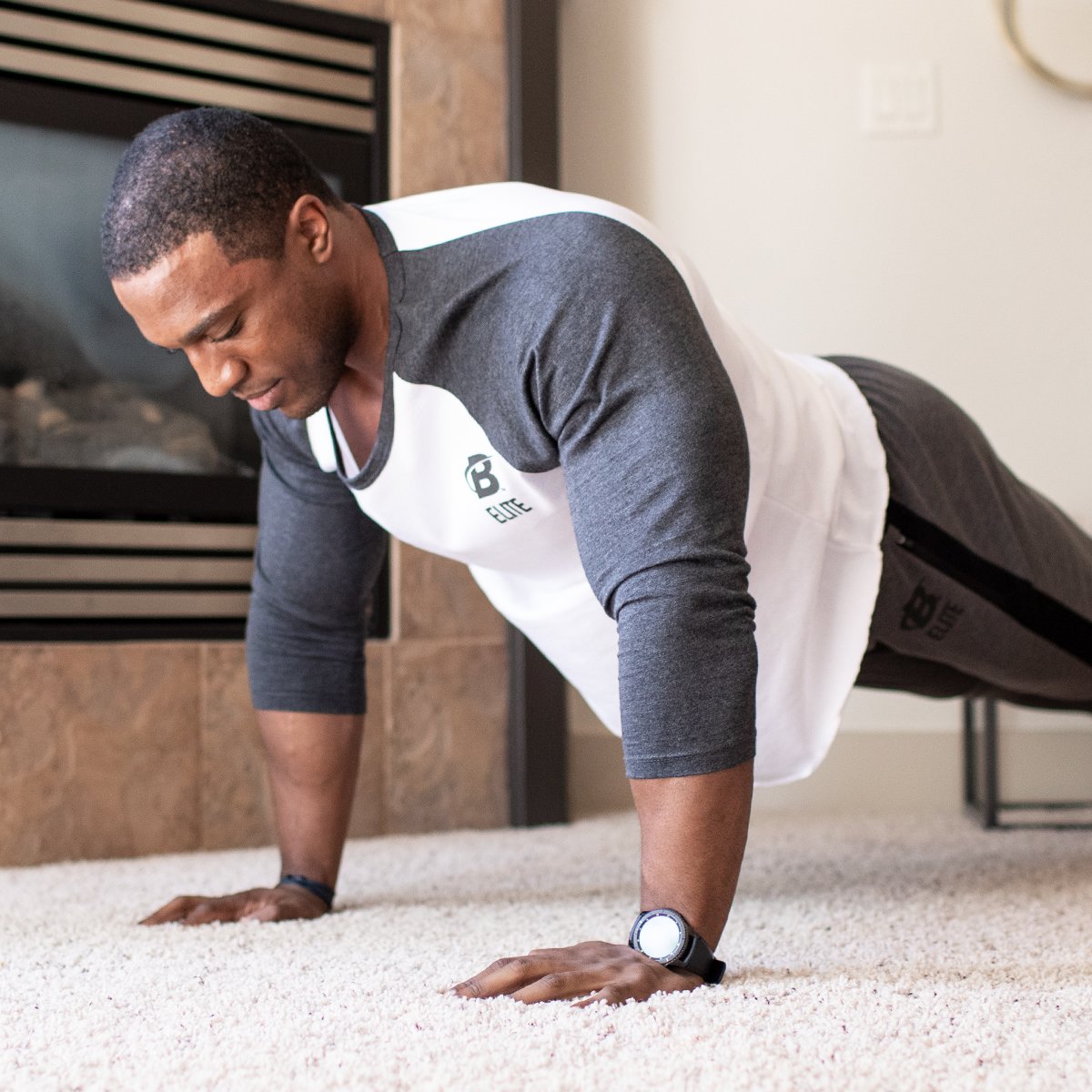You'll find no shortage of coaches and influencers out there these days telling you that working out at home is essentially "no different" than working out in the gym. Just keep using that good old progressive overload on an entirely different set of movements, and you'll be A-OK!
However, when equipment is at a premium, this is easier said than done. Sure, you can add in pauses, draw out the tempo of each rep excruciatingly, and otherwise crank up the difficulty. But your options definitely don't end there. You can—and I would argue should—also look for ways to increase the amount of work you do in your workouts, not just the difficulty or intensity of the work you do.
What's more, this training philosophy lends itself particularly well to equipment-limited workouts. Here are two techniques to help you put it into action, both from the new BodyFit Elite program Full-Body Muscle-Building Home Workouts.

Technique 1: Timed Cluster Sets
Look at the workouts in Full-Body Muscle-Building Home Workouts, and you'll see something a bit daunting. On Day 1, after a quick warm-up, there's this: Push-ups, 1 set, 4 minutes, with optional band or weight added to limit you to 6-10 reps at a time.
But…you can't do push-ups for 4 minutes straight. Especially not with added weight. So what are you supposed to do? Simple: Pace yourself and aim to maximize the amount of work you can do in that 4-minute time period.
Here's how it looks in action: Start a set, then stop at the first sign of a rep slowing down. Seriously, the first slow-down. No struggling allowed! Then rest 15-20 seconds, 30 if you really need it, and start again.
Training in this style, those 4 minutes will end up going by remarkably quickly—and you'll be able to accomplish a lot of reps. But they won't end up looking like "sets and reps" in the traditional way. It's more like a minutes-long continuous rest-pause set. This style of training also goes by the name of "cluster training," since you perform lots of mini-sets rather than just a few full sets.
Over subsequent workouts, try to either add time, or do more reps in the same time. In either case, if you're using the same weight, or just your body weight, you'll end up doing more work than you did in previous workouts. And guess what? That equals progressive overload. (Pro tip: If you're using weighted exercises, you can further expand the fun by tracking the total weight lifted during your time period and trying to increase that in subsequent workouts. This is a favorite approach of many powerlifters and other elite strength athletes.)
This overall strategy bears some similarity to a fantastic training system created by strength coach Charles Staley in the early 2000s, called Escalating Density Training (EDT). In Staley's EDT model, you alternate two antagonist movements for up to 15 minutes, resting as needed. Once you are to the point where you are cruising through your workouts, increase the weight or change the exercises.

Here's how he describes it: "The central premise is that fitness is the product of work output per unit of time. In a weight-training/hypertrophy context, as long as you don't exceed your recovery abilities, the more work you can do, the better results you'll experience."
The difference in Full-Body Muscle-Building Home Workouts is that you'll be performing a single movement for a shorter time period, and adding time rather than simply working in a fixed time. But the basic appeal is the same: Use time as a tool to help you do more total work, not just lift heavier.
But What About Training to Failure?
I hear you in the comments: "But isn't training to failure key for muscle gains?"
There are plenty of smart coaches who advocate taking at least some of the sets in your training to the point of "technical failure," where you couldn't squeeze out one more rep without your form going down the drain. Brad Schoenfeld and Jacob Wilson outlined the case for this training in their respective articles "Is Training to Failure Necessary?" and "Is Training to Failure Helping or Hurting Me?" and I'm not going to disagree with the effectiveness of it on certain movements.
But training to failure does come with a downside, as Wilson notes: "Once your nervous system is fatigued, all following sets will be performed at a much lower capacity. For example, if on one set you can get 10 reps at complete failure, you may only get 6 the second set. However, if you stopped at 9 reps on the first set, you likely would have been able to get 8 or 9 on the second set. This is because you have less central fatigue."
Think of it this way: In any particular workout, you have to make a choice between failure or volume. Move the lens out a bit farther, though, and there's nothing saying you can't get the best of both worlds. You just might not be able to do it at the same time. In other words, you can cycle your failure training.

Here's how. For four weeks, follow Full-Body Muscle-Building Home Workouts. After a solid month with this density-focused approach, switch to an approach like the one outlined by coach Paul Carter in the excellent new BodyFit program Jacked at Home: Bodyweight Muscle-Building Workouts. In Carter's plan, you perform many classic bodyweight movements to failure, and try to increase the total reps week over week.

Doing a phase of training to failure can allow you to set some solid rep benchmarks to inform your future density training, and also give your muscles a different type of overload. After a month of training to failure repeatedly, switching back to a model where you stop at the first sign of rep slowdown will be a welcome change!
Honestly, you could bounce back and forth between those approaches effectively for a long time. Here's what not to do: land somewhere between them. This means stopping a set 1-2 reps after you reach the point of slowdown, but still 1-2 reps short of failure. In that no man's land, you'll tax yourself enough to limit the volume you can achieve afterward, but not enough to benefit from training to failure.
Technique 2: Chip-Away Sets
This technique is like cluster sets, but in reverse. Rather than start with a unit of time and try to fit what you can into it, you'll start with a total number of reps—a lot of them—and use as much time and as many mini-sets as you as you need to get them done. By the end, a mini-set might be no bigger than a single rep.
In Full-Body Muscle-Building Home Workouts, an example of a chip-away set looks like this:
- Single-leg glute bridge: 1 set, 60 reps (alternating, 30 per leg) Perform 30 total reps per leg, broken up into as many sets as needed.
Not so bad, right? Rest assured, the rep goal goes up week by week. By comparison, on Day 1 of Jacked at Home, before doing push-ups and pull-ups to failure, you'll do a similar but even meaner Paul Carter protocol:
- Bodyweight walking lunge: 1 set, 100 reps (alternating, 50 per side) Rest as needed to complete all reps.
By the end of Week 4, you'll be up to 250 reps, or 125 per side. Now that's a pile of work. And that's kind of the point.
Doing ultra-high-rep sets like these forces you to think, and train, with a focus on pacing yourself and not burning out too quickly. It gives you a way to track progress workout to workout, and also create muscle and strength that's rooted in actually working hard, not just cranking out 45 seconds of work and expecting to grow on it.
A warning: Having done a lot of this style of training over the last few years, I can say that it makes me uniquely ravenous. Maybe you're different, but I'd still say: expect to eat. Also, in the first couple of workouts, stepping outside of the strict sets-and-reps approach can make one uniquely sore. (I have a short list of friends who expect a text from me about once every 3 months saying, "Welp, I've done it again. I have crippled my heinie.")
The upside, though, far outweighs the down. This is the sort of training you can make solid progress on for years, both in the gym and at home. To try it, check out Full-Body Muscle-Building Home Workouts and Jacked at Home, both in BodyFit.


